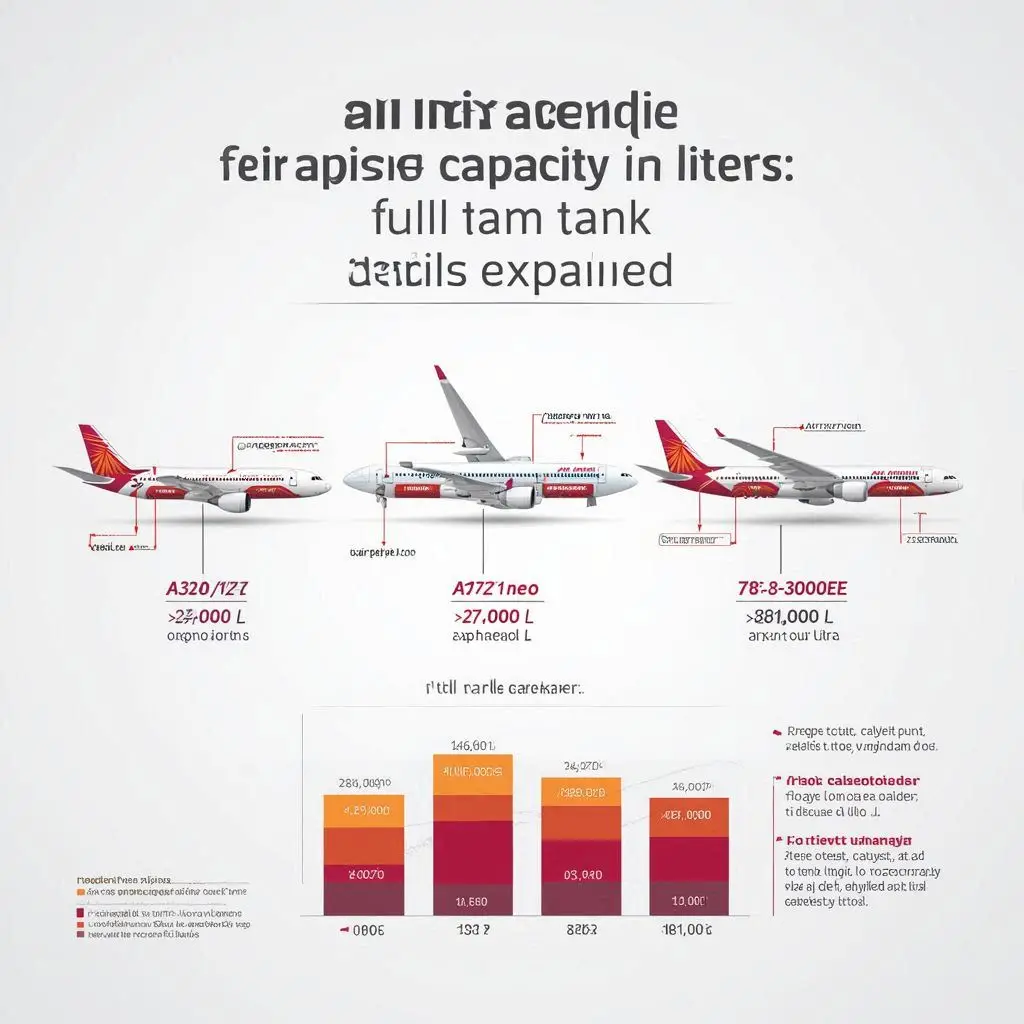
Air India Aircraft Fuel Capacity in Litres: Full Tank Details Explained
Understanding the fuel capacity of Air India planes is vital for aviation enthusiasts, travel bloggers, and industry professionals alike. From short-haul domestic jets to long-range international carriers, Air India's fleet uses varying amounts of jet fuel based on aircraft type, route, and operational efficiency. In this guide, we explore the detailed fuel capacity of Air India aircraft—measured in litres—and explain how fuel tank design impacts overall performance and range.
Introduction
Air India uses a wide range of aircraft, from narrow-body planes to large Airbus and Boeing jets, for both long and short routes. The size of each aircraft’s fuel tank plays a major role in how far it can fly. This article provides a detailed look at the fuel capacities of different Air India aircraft, offering both general insights and specific numbers in litres. Understanding aircraft fuel needs reveals the scale of Air India’s operations and the careful fuel planning that ensures safe, long-distance travel.
Air India Plane Fuel Capacity
Summary: This section explains what fuel capacity means and provides a general overview of Air India's fleet fuel capabilities.
Fuel capacity refers to the total amount of fuel an aircraft can carry within its tanks. Air India, as a major international carrier, operates aircraft with a wide range of fuel capacities depending on the aircraft's size, range, and purpose. For example, wide-body aircraft like the Boeing 777-300ER are used for intercontinental flights and have large tanks, while smaller planes like the Airbus A320 are used for regional routes and require less fuel.
Fuel is stored in various parts of the aircraft including the wings, fuselage, and sometimes auxiliary tanks. The capacity directly influences the aircraft's maximum flight range and payload. Air India's operational planning includes precise fuel load calculations to ensure safe, efficient travel while optimizing costs.
Air India Plane Fuel Capacity In Litres
Summary: This section converts the fuel capacity into litres for easier understanding and comparison.
While fuel capacity is often mentioned in kilograms or gallons in aviation, converting it to litres provides a clearer picture for most readers. Here’s a breakdown of approximate fuel capacities in litres for common Air India aircraft:
- Boeing 777-300ER: ~181,283 litres
- Boeing 787-8 Dreamliner: ~126,917 litres
- Airbus A320neo: ~24,210 litres
- Airbus A321neo: ~29,680 litres
- Boeing 747-400 (now retired): ~216,840 litres
It’s important to note that not all fuel is usable during flight. A portion is reserved for contingencies such as diversions, holding patterns, or delays. These figures represent total tank capacity under standard configurations.
Air India Plane Fuel Tank Capacity
Summary: Learn how the aircraft's tank system is structured and how it affects flight operations.
The fuel tank system is an engineering marvel, integrated into the aircraft’s wings and central fuselage. Modern Air India aircraft, particularly the Boeing 787 Dreamliner and A320neo, feature highly efficient composite fuel tanks that reduce weight while maximizing fuel load.
The way an aircraft’s fuel tanks are arranged makes a big difference in flight. Air India’s long-range jets use center tanks for mid-flight fuel and wing tanks for the early stages. Cockpit-controlled systems—comprising pumps, sensors, and automation tools—regulate fuel flow and keep the aircraft balanced throughout the journey.
Proper tank usage and monitoring are critical for maintaining aircraft balance, especially during long-haul operations when fuel burn changes weight distribution over time.
Fuel Efficiency and Flight Range of Air India Aircraft
Summary: Discover how fuel capacity connects to flight range and fuel efficiency per aircraft.
Fuel efficiency is measured in litres per kilometre or passenger per kilometre. Air India’s investment in modern aircraft like the Boeing 787 and A320neo enhances fuel economy. Here’s how fuel tank capacity relates to flight range:
- The Boeing 777-300ER, one of Air India’s flagship long-haul aircraft, offers an impressive range of approximately 13,650 kilometers when its fuel tanks are fully loaded.
- Boeing 787-8: Range ~13,530 km
- Airbus A320neo: Range ~6,300 km
- Airbus A321neo: Range ~7,400 km
Air India uses aircraft with optimal tank sizes for specific routes. Domestic routes like Delhi to Mumbai typically require less than 5,000 litres of fuel, while intercontinental flights from Delhi to New York may consume over 100,000 litres.
These aircraft also incorporate aerodynamic design and engine technology that improve fuel burn efficiency, reducing operating costs and environmental impact.
Jet Fuel Type, Cost, and Refueling Operations
Summary: Get to know the type of fuel used, its cost, and how Air India manages refueling.
Air India aircraft primarily use Jet A-1 fuel, a kerosene-based aviation fuel with a freezing point of -47°C. Jet A-1 is globally standardized and used for both domestic and international flights. On average:
- Jet A-1 density: ~0.8 kg/litre
- Price per litre (2025 est.): ₹80–₹95/litre in India (subject to location and taxes)
For a Boeing 777 requiring ~180,000 litres, the fuel cost alone can exceed ₹14 million per flight.
Air India refuels its aircraft either through fixed airport fuel farms or mobile fuel trucks known as bowsers. The process includes multiple safety checks, grounding, volume calibration, and fuel sampling. Efficient refueling logistics minimize delays and ensure adherence to flight schedules.
Conclusion
Air India’s aircraft fuel capacities vary significantly based on aircraft type and mission. From 24,000 litres in regional A320 jets to over 180,000 litres in long-haul Boeing 777s, each tank is designed with precision to serve specific operational needs. Understanding these capacities in litres gives deeper insight into the scale of air travel and the complex logistics behind every takeoff. As Air India continues to modernize its fleet, fuel efficiency, cost optimization, and environmental compliance remain at the forefront of its aviation strategy.

